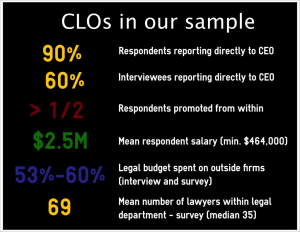As corporate legal departments have grown in size and sophistication, they wield increasing power over the legal market. How do major companies select, work with, and decide to fire outside law firms? The Center on the Legal Profession examined these questions in a survey of general counsel and chief legal officers (CLOs).
The responses are a fascinating look at the decision making of CLOs as they seek to balance imperatives like cost control and legal outcomes with the value of long‐term law firm relationships.

Respondents came from a range of industries weighted toward those with high legal costs: finance (investment and commercial banks), pharmaceutical, and petroleum industries. All were from companies ranking on the S&P 500. In-house lawyer counts at the companies varied widely, from an average of 35 to more than 1,200, as did legal spending, which ranged from an average of $37 million to more than $600 million.



The survey was conducted in the United States between 2003 and 2006, and therefore reflects the US market before the financial crisis of 2008–2009 and resulting economic downturn. The Center on the Legal Profession is collecting data to update this study in the US and European markets as well as in the world’s emerging economies in order to provide a snapshot of the post-recession legal market. Still, we believe our findings have structural roots that likely transcend—and may even be exacerbated by—the downturn, during which large companies have cut back significantly on spending and many law firms have undergone layoffs.
Choice criteria
How do CLOs select outside law firms? Survey respondents were quick to mention discounts, blended rates, and other restrictions on costs such as travel expenses, particularly in the wake of the reduction in outside law firms—known as convergence—that began in the 1990s. Indeed, many mentioned such conditions were necessary to even “get on the list.”
Study methodology
The Corporate Purchasing Project, conducted by Center on the Legal Profession Faculty Director David B. Wilkins and Research Director John C. Coates IV, was a systematic survey of 139 S&P 500 companies. It included focus groups and interviews with general counsel in commercial and investment banking, petroleum, and pharmaceutical companies, along with a rigorous nonrespondent analysis.
Learn more about the Corporate Purchasing Project here.
Since our survey asked solely about important legal issues, cost and efficiency were understandably not primary selection factors for in-house counsel. Instead, more than 60 percent of CLOs said results in similar cases, reputation, and prior relationship were very important—more so than firm size, market reach, quality control systems, commitment to diversity, or ethical infrastructure. Some assume relationships have declined in an age of increasing information asymmetry, as in-house clients become increasingly informed about their own legal needs. We found this not to be true—in fact, large companies continue to hire outside legal help based primarily on existing relationships.

In addition, we found evidence that the trend toward convergence may be slowing. After DuPont famously reduced its outside-firm relationships from 350 to just 35 in the early 1990s, many corporate legal departments followed in its wake. However, 38 percent of respondents in our survey reported maintaining a steady number of outside relationships during the study period. Nevertheless, a small number of firms still receive the overwhelming majority of corporate legal spending. The median company in our survey gave 80 percent of its business to less than 25 firms, and many maintained relationships with fewer than 10 firms. These figures underline a key finding of the survey: relationships still matter.
CLOs rely on their experience when making hiring decisions—fully 97 percent of CLOs told us that the most important source of information in making hiring decisions is personal knowledge (either their own experience with the specific outside lawyers or law firm or their personal knowledge of the lawyers’ or law firm’s reputation). Three-quarters talked with colleagues at their own firm, and half with peers at other firms. Yet only 17 percent consulted public sources of information such as rankings or court records. As a result, our interview data indicate that the way CLOs hire outside counsel has not yet materially changed.

It is interesting to note that, for those who did consult outside rankings, prior experience became a less important criteria, while firm size, geographic reach, and commitment to diversity assumed more significance. External factors like these may gain in importance when selecting new clients if industry-wide rankings become more trusted and well known, but for now, relationships still dominate.
It isn’t surprising that CLOs continue to place so much emphasis on prior experience, reputation, and results—and their own and their colleagues’ ability to assess these factors. Each of these factors can be seen as a proxy for the difficult-to-evaluate criterion of quality. For outside firms looking for new business, this means cultivating personal relationships and emphasizing the points that set you apart from your competition, particularly past experience with an issue, rather than using generic descriptors like “expertise.”

Disciplining firm teams
What happens when in-house counsel are dissatisfied with an outside firm? Standard depictions of the corporate legal market over the past two decades might lead one to believe that large companies frequently terminate law firm relations as sophisticated CLOs (inspired by former General Electric general counsel and current Center on the Legal Profession Distinguished Senior Fellow Ben Heineman, Jr.) shifted the purchasing model from relatively uncompetitive, long-term, static relationships between large companies and law firms to spot contracting on individual matters.
Contrary to that story, relatively few survey respondents (about 20 percent) reported terminating preferred provider law firm relationships more than once or twice over the period in question (2003-2006). And more than 30 percent reported never having terminated such relationships.

Companies with small- or medium-sized legal departments were more likely to end preferred relationships than companies with large departments, while medium‐sized departments appeared most active, with over 75 percent reporting firm turnover. This may be because small legal departments are more dependent on outside law firms, while companies with large legal departments have more ties between in‐house lawyers and lawyers at firms, making both types of companies less likely to formally discipline their providers.

The penalty box
If cutting off an entire law firm is rare, what tools do CLOs use to discipline law firms instead? Work reductions—described by some respondents as being “put in a penalty box”—seem to have become the tool of choice for CLOs seeking to manage law firm relationships. Indeed, 80 percent of CLOs reported having reduced work to a law firm as a disciplinary measure in the study period. CLOs may recognize that firing a law firm will not solve problems of poor service.
While performance issues may be attributable to the quality, responsiveness, or lapse in judgment of a single attorney, we found that resulting work reductions are seldom confined to the individual level. Instead, a majority of work reductions (54 percent) encompassed the entire team or department of an underperforming individual. Dissatisfaction with a partner, in other words, spread to the whole team.
These results suggest that as law firms have grown in size and scope, the relevant units of choice for companies have shifted from law firms to teams and departments. For CLOs of large companies, individual lawyers can function as effective corporate counsel only in conjunction with other lawyers in the same functional unit at their firms.
Reasons for dismissal
Quality of service led the list of reasons for reducing work or ending a relationship (60 percent of CLOs reporting terminations, and 78 percent of those reporting reductions). Just as cost is not a significant factor in hiring for important legal matters, cost was also cited as a factor in just 7 percent of terminations. This suggests fees may be less important after a formal relationship is established than other, more significant determinations of quality.
After quality, the most prevalent reasons for terminating law firms centered on ethics, particularly conflicts of interest (27 percent for terminations; 10 percent for reductions). If a law firm accepts work for a client’s competitor, giving rise to a possible conflict of interest, the client may see this as breaking a soft promise of capacity assurance. Ethical breaches were likely to be seen as a betrayal and lead to termination—particularly accepting work from a party suing the company, which one respondent called a “fundamental affront to our dignity.”
As one respondent noted of their preferred providers, “The better firms know … we have a high-level expectation that our key firms are not going to be doing things anywhere, whether it’s for us or for some other clients, that is at odds with our interest.”
This suggests—in contrast to the management of quality and responsiveness at the team or department level—that ethics are perceived by CLOs as important to manage across the entire law firm. As such, lapses by one lawyer or team reflect poorly on the firm as a whole.
Lateral moves
Do in-house legal departments follow when a “star” leaves a firm? Little data has previously been available to answer this question. Our survey revealed the answer is largely yes.
More than half of survey respondents (54 percent) reported seeing star lawyers at law firms move laterally during the three-year study period. And despite possible conflicts of interest or the threat of damaging relationships, most CLOs moved their work to the new firm a star lawyer joined. Nearly 70 percent of CLOs said they do so “every time,” and 84 percent said they do so in a majority of instances. Perhaps not surprisingly given the added value of team‐wide, client‐specific experience, CLOs were significantly more likely to move work when the star lawyers moved as part of a team than when the star lawyer moved solo. Work levels were not affected following these star moves—it either stayed the same at the new firm, or even improved in 20 percent of cases.
Risks of convergence
The convergence of previous decades may have cut in-house legal spending, but it has also revealed the limits and risks of tying a company’s fortunes to an ever‐smaller group of firms. CLOs will have to find more creative ways to manage their law firm relationships.
Despite their stated reluctance to intervene in law firm affairs, many CLOs are now experimenting with a range of new ways of managing down costs and increasing quality. Some CLOs are initiating firm‐integrated strategic planning and introducing common technology linked with outside counsel for knowledge and case management. Many believe that new forms of legal organizations, off‐shoring, and continued pressure on the boundary between commodity and bespoke legal work will do more to constrain costs and enhance quality than discount mandates or so-called beauty contests. Many are also pushing to replace an hourly billing system with alternative fee arrangements and other forms of risk and profit sharing with their law firms.
Yet efforts to cut costs and unbundle entail risks to quality as well. To guard against these risks, CLOs may have to follow the lead of the small but significant minority who have begun to collect external, objective sources of information about legal quality. Law firms’ management structures, compensation systems, and work-assignment procedures can be reviewed, evaluated, and—with enough pressure—changed to improve productivity.
Durable relationships don’t mean hands off
The good news is that law firms’ relationships with large corporate clients are relatively durable, ensuring a reliable flow of revenues over time, absent serious lapses. Convergence has already run its course, and there is little more companies can do to winnow preferred provider lists without causing excess dependency on a small set of law firms. The bad news is that CLOs are more informed and savvy purchasers of legal services than ever before.
Law firms will increasingly need to justify many business practices they have previously treated as internal. Corporate clients are already intervening in once purely internal areas, such as staffing, specifying particular partners and associates to work on their matters—and for how long. Such demands respond to concerns about diversity. Some companies have required law firms to report on the demographic composition of lawyers working on the company’s matters, and in some cases mandated that firms change the “relationship partner” overseeing the company’s business.
Law firms will increasingly need to justify many business practices they have previously treated as internal.
As a result, firms should institute mechanisms to signal they are responsive to client concerns. Consider communicating commitment, transparency, and business alignment via dedicated client teams, client-accessible data-management platforms, law firm–run training programs for both in‐house counsel and business units, and secondments of law firm lawyers to companies.
Defining client focus
What does it mean to be client-focused? In survey responses, legal officers had a number of suggestions for outside law firms. Here’s what they identified as important:
- Responsiveness. Return emails and phone calls promptly. Be attentive, one CLO advised: “If we call you at four o’clock, you call us back at five.”
- Follow direction. When in-house counsel provide direction based on their knowledge of their own business practices, listen. Don’t assume your work will be largely autonomous—instead, work collaboratively with in-house experts, and ask questions to be sure you fully understand the client’s problem before recommending solutions.
- Remember your client’s client. While the CLO may be your client, their client is the business side of their organization. As one respondent noted, firms “must understand our business and be able to work well with our business people. I generally select people that the business people trust.” Listening for and answering to the needs of the ultimate end user of your work will improve relationships and outcomes.
- Keep your eye on the ball. Tie legal strategies to your client’s broader business goals, and don’t leave the client out of the loop in important developments in a case. “I want a law firm that’s very focused from the beginning on how the case is ultimately going to be resolved,” one respondent said—as opposed to “no true evaluation of a case until very late in the game.”



